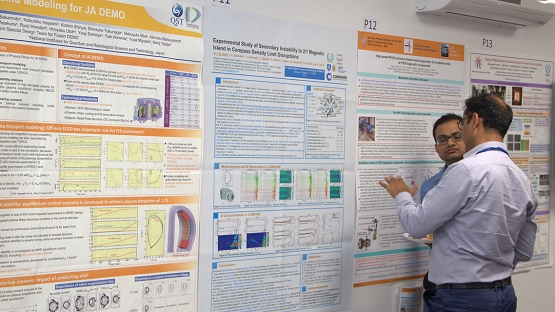The design of a future Demonstration Fusion Power Plant (DEMO) was the topic of discussion at an IAEA workshop held in in Moscow, Russia, earlier this month. Researchers are currently developing different concepts for a DEMO, which should prove that fusion power can be used to generate electricity safely, consistently and reliably.
Fusion research aims to harness the power generated by the fusion of light nuclei, a process comparable to the energy production of stars. It holds the promise of abundant, safe and carbon free energy. A DEMO represents an important step between ITER, an international nuclear fusion research and engineering megaproject which is currently the world’s largest fusion experiment, and any future Pilot Fusion Power Plant. ITER is not meant to generate electricity. Rather it will demonstrate for the first time net fusion energy production, meaning that for 50 MW of injected heating power it will produce 500 MW of fusion thermal power. A future Pilot Fusion Power Plant should make the vision of large-scale commercial electricity production a reality.
“The scientific and technological developments of technologies for a DEMO need international coordination and collaboration,” said Elizabeth Surrey, Head of Technology at the United Kingdom’s Atomic Energy Authority and chair of the workshop. “The IAEA’s DEMO Programme Workshop paves the way for a common roadmap to achieve fusion power for electricity production.”
Around 60 experts from 14 countries, the European Union’s Fusion for Energy organization and the ITER Organization participated in the workshop. They also visited the Kurchatov Institute, where the first vessel for a fusion experiment, the T-1 Tokamak was built in 1958.
The development of a DEMO faces a multitude of challenges going beyond solutions to be provided by ITER. ITER, expected to be operational by 2025, will produce controlled fusion reactions in long pulses, each lasting only a few hundred seconds.
The DEMO design should allow continuous or near-continuous operation. In a DEMO, the containment needs to hold the plasma in place, while maintaining its density at even higher temperatures than in ITER. Avoiding disruptions in the plasma and keeping it stable over extended periods of time presents another major challenge.
“The presence of top representatives of the international fusion community and the practical focus on plasma stability, material sciences and impact of operational conditions makes this year’s workshop yet again extremely valuable,” Surrey added.
There is not a single definition or design for a DEMO Power Plant – different groups of researchers pursue different approaches. But these have a lot in common: a DEMO machine should be a tokamak reactor using Deuterium and Tritium as fuel and should be a more advanced machine than ITER.
In such a tokomak, fuel is heated to more than a hundred million degrees. The result is a plasma which consists of freely moving electrons and ions. Under these extreme conditions the positively charged atomic nuclei fuse and release energy. While these nuclei are confined by the tokomak’s magnets and sustain the heating of the plasma, 80 per cent of the energy is carried away by neutrons. These energetic neutrons hit the reactor walls, or “blankets”, and their energy can be used for electricity production.
During the IAEA workshop series, which takes place every two years, the main scientific and technical challenges of a DEMO are discussed and programs, tasks and various possible courses of action are analysed. Although each country may have individual research priorities, the objective of the workshops is to coordinate mutually beneficial efforts and facilitate international collaboration.
All information related to the 6th IAEA DEMO Programme Workshop, including presentations can be found here.





